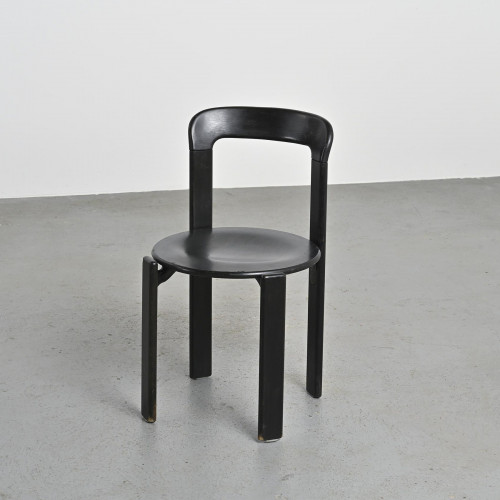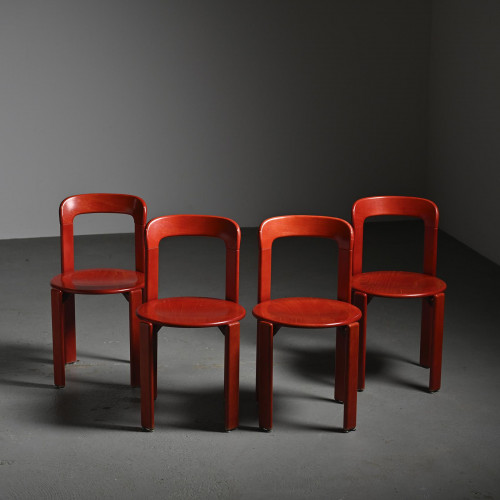Bruno Rey (1935)
Bruno Rey was born in 1935 in the canton of Aargau, Switzerland. He first trains as an apprentice in cabinet-making and before studying at the University of Design Kunstgewerbeschule Zürich - now called ZHdK. He takes classes offered by Willy Guhl, a well-known Swiss designer. After graduating in 1960, he travels extensively in Switzerland and abroad, working in several architectural firms. At the same time, he occasionally designs his personal furniture creations. His internship with Paul Sumi, an interior designer, allows him to develop a particular attraction for chairs.
Throughout his career, Bruno Rey tries a variety of projects, from interior design to gardens, creating fiber cement plant trays for Eternit AG and a control room for the Mühleberg nuclear power plant. Nevertheless, he encounters difficulties in having his first prototypes produced, so he ends up doing them himself, with limited success.
In 1966, he participates in the founding of the Swiss Design Association SDA with several other renowned designers such as Andres Christen, Eugen Gomringer, Willy Guhl and Kurt Thut. This association, which is still active today, aims to promote and support the work of professional designers in Switzerland.
In 1968, he opens his own architecture and design studio in Baden, in his canton of birth.
Until 1971, inspired by the work of Charles and Ray Eames, he produces molded plastic parts. Then, inspired by Thonet and one of his chairs from the mid-nineteenth century, he turns to wood. He removes the frame of the seat by opting for a
Bruno Rey was born in 1935 in the canton of Aargau, Switzerland. He first trains as an apprentice in cabinet-making and before studying at the University of Design Kunstgewerbeschule Zürich - now called ZHdK. He takes classes offered by Willy Guhl, a well-known Swiss designer. After graduating in 1960, he travels extensively in Switzerland and abroad, working in several architectural firms. At the same time, he occasionally designs his personal furniture creations. His internship with Paul Sumi, an interior designer, allows him to develop a particular attraction for chairs.
Throughout his career, Bruno Rey tries a variety of projects, from interior design to gardens, creating fiber cement plant trays for Eternit AG and a control room for the Mühleberg nuclear power plant. Nevertheless, he encounters difficulties in having his first prototypes produced, so he ends up doing them himself, with limited success.
In 1966, he participates in the founding of the Swiss Design Association SDA with several other renowned designers such as Andres Christen, Eugen Gomringer, Willy Guhl and Kurt Thut. This association, which is still active today, aims to promote and support the work of professional designers in Switzerland.
In 1968, he opens his own architecture and design studio in Baden, in his canton of birth.
Until 1971, inspired by the work of Charles and Ray Eames, he produces molded plastic parts. Then, inspired by Thonet and one of his chairs from the mid-nineteenth century, he turns to wood. He removes the frame of the seat by opting for a
plywood seat that is strong enough, connects the seat and base with aluminum. However, the first attempts are too fragile.
He begins a collaboration with the Swiss furniture company Dietiker & Co for which he designs several series of chairs, among which the model 3300, the Rey Chair which is to become an icon of Swiss design with its unique screw-less metal to wood connection. From 1970 to 1979, he also works with Kush+Co, a German company for which he designs beech and leather chairs.
In 1977, he began a long collaboration with another Swiss designer, Charles Polin. They both share a strong interest in seating and aim to "create a chair with universal features and not just a one-off". Their joint research spanned four years and led to a first result in 1980: the Quadro W chair. Made of solid beech, the seat and backrest are connected by four chrome-plated flexible steel springs that inspire the model name. The legs, equipped with a rotating system, make it possible to stack the chairs. Simple, comfortable and very innovative, this chair is produced by Dietiker starting in 1989.
Building on this success, Rey and Polin move to a farm in Gebenstorf where their workshop is better equipped to build prototypes, thus allowing them to experiment innovative design and assembly techniques. Together they continue to design several flagship pieces of furniture produced by Kusch + Co and Dietiker, such as the XY table produced in 1995 and the stackable chair Patron.
Bruno Rey's best-known chair is certainly the Rey model 3300. Published by Dietiker from 1971 and sold in more than 1.5 million copies, it is an icon of the 70s. Very elegant, it is also sturdy, practical and of course stackable.





